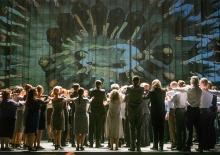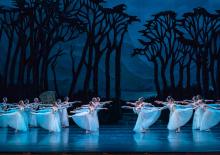How does it work, having three people at the helm of one organisation? Do you set the artistic direction together?
Ted Brandsen: “Yes, we align our programming choices; but only the contours, not the finer details. Sophie and I do this individually for our respective companies. I wouldn’t, for instance, say to her, ‘You should do Verdi again’.”
Sophie de Lint: “Ted and I develop our own programming, but at the same time we have a joint responsibility to serve our art forms: opera and ballet. This means that together with Stijn, we make sure that our organisation is well equipped to fulfil our artistic ambitions.”
Ted Brandsen: “Expectations are always high for Dutch National Opera & Ballet, and rightly so. There is an expectation that we distinguish ourselves at home and abroad through high-quality productions, that we invest in developing young talent, but also that we reach a wide audience and are a reflection of society, both on the stage and behind the scenes. As a large cultural organisation, we have the obligation – as well as the desire – to shoulder a lot of responsibility.”
Stijn Schoonderwoerd: “Recently this has also included sustainability, something that for a long time rarely played a role for cultural institutions. Now, it’s a key theme. So much so that some time ago we appointed a project manager who is tasked with challenging us to improve the sustainability of our production processes. And recently we assessed the environmental impact of the materials we use for sets, costumes and props. The results of this will inform the conversations our workshops have with designers about the environmental impact and sustainability of their designs going forward.”
‘Our mission: to enrich the lives of as many people as possible with the wonder, beauty and meaning of opera and ballet’
Is the business side of things the main focus of the board of directors’ work?
Stijn Schoonderwoerd: “Operational matters take up some of our time, but certainly not all of it. When the three of us started working together, the first thing we did was discuss our mission, both as an organisation and on a personal level. And we soon agreed that this is to enrich the lives of as many people as possible with the wonder, beauty and meaning of opera and ballet. That is what connects us. It’s important that we established this shared foundation; it gives rise to all kinds of meaningful themes.”
Ted Brandsen: “As the general director, Stijn also puts these overarching topics on the agenda. So, for example: What do we want to achieve with our productions? Do people actually feel welcome in our theatre? What is our relevance as a house of classical art forms in this diverse city and ever-changing society? And what is our position in the international realm of opera and ballet companies? These aren’t questions of an operational nature; they involve matters of content and strategy which have an impact on the programming.”
Stijn Schoonderwoerd: “But I don’t get involved in the artistic decisions on stage. My role is assessing these with more distance and to ask my fellow directors questions from that point of view.”
Sophie de Lint: I think it’s good we challenge each other in this way. It allows us to continue fine-tuning our artistic and social profile. Various departments also play a role in this, including dramaturgy, education and marketing. By looking at our programming from these different perspectives, we hope to strike a good balance in the season, with cherished classics such as Giselle and Lohengrin, but also new pieces and children’s productions that appeal to completely different audiences.”
Stijn Schoonderwoerd: “Ultimately, it’s not important whether our visitors say they’ve been to the opera, the ballet or to Dutch National Opera & Ballet; as long as they’ve been impacted on an intellectual or emotional level. And I think it’s important that our visitors feel welcome, that Dutch National Opera & Ballet is a place where they experience exceptional moments and high quality at all times.”
But what does high quality mean when you programme such a diverse range of productions? Can the same quality standards be applied to such varied productions?
Ted Brandsen: “For us, quality is partly about the level of the creative teams and the performers; the audience witnesses the work of people who excel in their discipline and who therefore also receive international recognition. But it’s also about the adventure that we seek, the artistic experiment. In the arts, you have to take risks to move forward: quality is never a static thing.”
Sophie de Lint: “For me, quality also has a lot to do with authenticity and craftsmanship, and that craftsmanship can definitely be found away from classical opera and ballet traditions as well. An example is the libretto of the children’s production The Theory of Everything written by Roziena Salihu, who has proven her talent as a spoken word artist. And the quality of The Shell Trial is in part determined by the experiences of its directors, Romy and Gable Roelofsen, who have been creating socially engaged art projects for years with their music theatre company Het Geluid Maastricht.”
Stijn Schoonderwoerd: “When you collaborate with a partner who has a different area of expertise and you’re both genuinely interested in each other’s work and approach, ideas about quality can develop mutually. The same is true for the collaborations we achieve here in house between opera and ballet, like this season with Oedipus Rex / Antigone.”
Ted Brandsen: “Absolutely. And here, too, you see the value of the experiment. Wayne McGregor, the production’s choreographer and director, is always seeking connection with other art forms. Connecting different genres, his work doesn’t shy away from extreme risks. That is what makes him one of the most important directors of our time.”
Stijn Schoonderwoerd: “We’ll open Studio Boekman this season, which means we will have a place where we can stimulate these types of developments. The venue is intended as a space where we can begin new partnerships with artists and institutions from different corners of the cultural world. A place where creatives will be encouraged to experiment and innovate and where we, as an organisation, can explore new forms of programming – from club nights to open rehearsals.”
‘It’s important that Dutch National Opera & Ballet is a place where our visitors feel welcome’
You’ve put together a new season. Which productions on your co-director’s programme do you look forward to the most?
Ted Brandsen: “I’m especially looking forward to Innocence, a new opera by a renowned modern composer, with a gripping story. And to Mahagonny, an opera by Kurt Weill, directed by Ivo van Hove.”
Sophie de Lint: “I like to see Dutch National Opera & Ballet as an artistic family, and therefore I am very curious about the new projects of two of our family members: Juanjo Arqués in the autumn and Milena Sidorova in the spring. It is exciting to be able to follow the development of these artists.”
Stijn Schoonderwoerd: “And I am looking forward to Alexei Ratmansky’s ballet programme Stravinsky Fairy Tales, for a personal reason. I have very fond memories of my involvement as managing director of Dutch National Ballet in the production of Ratmansky’s Don Quichot, and it’s a pleasure to see his work again on our stage. I’m also looking forward to seeing how a highly relevant topic such as the current climate crisis is translated into an opera in The Shell Trial. This production shows how we can put social themes on the agenda in our theatre in a powerful and immersive way.”


